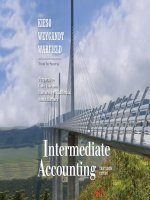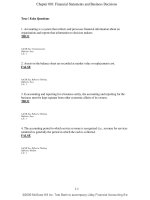Managerial accounting 6e jams jambalvo chapter 03
Bạn đang xem bản rút gọn của tài liệu. Xem và tải ngay bản đầy đủ của tài liệu tại đây (1.62 MB, 53 trang )
Prepared by Debby Bloom-Hill
CMA, CFM
CHAPTER
CHAPTER 33
Process Costing
Difference
Difference Between
Between Job-Order
Job-Order and
and Process
Process Costing
Costing Systems
Systems
Job-Order Costing
Each unique product or batch is considered a job for which cost information
is needed
Necessary to trace manufacturing costs to specific jobs
When completed, cost of job is removed from Work in Process and included
in Finished Goods
Slide 3-3
Learning objective 1: Describe how products flow through departments and how costs flow through accounts.
Difference
Difference Between
Between Job-Order
Job-Order and
and Process
Process Costing
Costing Systems
Systems
Process Costing
Large quantities produced of homogeneous products
Average cost = total costs divided by total number of items produced
When completed, number of units completed times average cost determines
cost to be moved from WIP to Finished Goods
Slide 3-4
Learning objective 1: Describe how products flow through departments and how costs flow through accounts.
Test Your Knowledge 1
Which of the following characteristics are associated with a process costing system?
a.
b.
Heterogeneous products
Homogeneous products
Answer: b
.Heterogeneous products are unique
.Homogeneous products are identical
Process costing is associated with identical products
Slide 3-5
Learning objective 1: Describe how products flow through departments and how costs flow through accounts.
Test Your Knowledge 2
Which of the following characteristics are associated with a process costing
system?
a.
b.
Continuous production
Discontinuous production
Answer: a
.Job order costing is associated with discontinuous production
.Process costing is associated with continuous production
Slide 3-6
Learning objective 1: Describe how products flow through departments and how costs flow through accounts.
Test Your Knowledge 3
Which of the following characteristics are associated with a process costing
system?
a.
b.
Costs are traced to jobs
Costs are traced to processing departments
Answer: b
.Job order costing requires tracing costs to jobs
.Process costing is associated with tracing costs to departments
Slide 3-7
Learning objective 1: Describe how products flow through departments and how costs flow through accounts.
Test Your Knowledge 4
An example of a business requiring a process costing system would be
a(n):
a.
b.
c.
d.
Custom cabinet shop
Antique furniture restorer
Soap manufacturer
Automobile repair shop
Answer: c
A soap manufacturer produces many identical units
Slide 3-8
Learning objective 1: Describe how products flow through departments and how costs flow through accounts.
Job-Order
Job-Order Costing
Costing System
System
Slide 3-9
Learning objective 1: Describe how products flow through departments and how costs flow through accounts.
Process
Process Costing
Costing System
System
Slide 3-10
Learning objective 1: Describe how products flow through departments and how costs flow through accounts.
Product
Product Flows
Flows through
through Departments
Departments
Manufacturing operations typically pass through two or more departments
Costs are accumulated in each department
Easy to identify when materials are added
Harder to identify when labor and overhead are added
Often grouped together as conversion costs
Assumed to be added evenly throughout the process
Slide 3-11
Learning objective 1: Describe how products flow through departments and how costs flow through accounts.
Test Your Knowledge 5
The costs in a process costing system are traced to:
a.
b.
c.
d.
Specific jobs
Specific customers
Specific company administrators
Specific production departments
Answer: d
Specific production departments
Slide 3-12
Learning objective 1: Describe how products flow through departments and how costs flow through accounts.
Cost
Cost Flows
Flows through
through Accounts
Accounts
The product costs accumulated in process costing are the same as in job-order
costing
Direct materials
Direct labor
Manufacturing overhead
A processing department might have transferred in costs from another department
Each processing department accumulates product cost in a separate Work in
Process account
Slide 3-13
Learning objective 1: Describe how products flow through departments and how costs flow through accounts.
Cost
Cost Flows
Flows through
through Accounts
Accounts
Direct Material
Slide 3-14
Suppose that $142,000 of direct materials are used
Journal entry:
Learning objective 1: Describe how products flow through departments and how costs flow through accounts.
Cost
Cost Flows
Flows through
through Accounts
Accounts
Direct Labor
Slide 3-15
Suppose that $62,200 of direct labor costs are incurred
Journal entry:
Learning objective 1: Describe how products flow through departments and how costs flow through accounts.
Cost
Cost Flows
Flows through
through Accounts
Accounts
Manufacturing Overhead
A company may use either actual overhead costs or a predetermined overhead rate
to assign overhead to products
Unless production and overhead costs are constant from month to month, use of
actual overhead may result in substantial fluctuations in the unit cost
For that reason most companies use a predetermined overhead rate
Slide 3-16
Learning objective 1: Describe how products flow through departments and how costs flow through accounts.
Cost
Cost Flows
Flows through
through Accounts
Accounts
Manufacturing Overhead
Slide 3-17
Suppose manufacturing overhead is applied at a rate of $3 per direct labor dollar
Journal entry:
Learning objective 1: Describe how products flow through departments and how costs flow through accounts.
Cost
Cost Flows
Flows through
through Accounts
Accounts
Transferred-in Cost
When a department completes its work, the items are transferred to the next
department
Slide 3-18
Related costs are transferred as well
Suppose the Mixing Department completed units with a cost of $360,000
Learning objective 1: Describe how products flow through departments and how costs flow through accounts.
Flow
Flow of
of Costs
Costs Between
Between
Processing
Processing Departments
Departments
Slide 3-19
Learning objective 1: Describe how products flow through departments and how costs flow through accounts.
Calculating
Calculating Unit
Unit Cost
Cost
Equivalent Units
Partially completed units are converted to a comparable number of completed units,
called equivalent units
Multiply the number of units by the percent complete to calculate the equivalent units
100 units that are 50% complete are equivalent to 50 complete units (100 x 50%)
Equivalent units may be different for material and conversion costs if materials and
conversion costs enter production at different times.
Learning objective 2: Discuss the concept of an equivalent unit and calculate the cost of goods completed and
Slide 3-20
the ending Work in Process balance in a processing department.
Equivalent
Equivalent Units
Units –– Material
Material and
and Conversion
Conversion Costs
Costs
Learning objective 2: Discuss the concept of an equivalent unit and calculate the cost of goods completed and
Slide 3-21
the ending Work in Process balance in a processing department.
Calculating
Calculating Equivalent
Equivalent Units
Units
Equivalent units are normally calculated for materials and conversion costs
The equivalent units produced is the sum of the units finished and the units in
ending work in process
Units finished are always 100% complete in terms of materials and conversion
costs
Multiply the number of units in ending work in process by the corresponding
percent complete to calculate the equivalent units
Learning objective 2: Discuss the concept of an equivalent unit and calculate the cost of goods completed and
Slide 3-22
the ending Work in Process balance in a processing department.
Test Your Knowledge 6
At Rainier Chemical, conversion costs (labor and overhead) enter evenly throughout the
production process. At the end of the year, 200 units in work in process are 80 percent
complete. With respect to conversion costs, how many equivalent units are in work in
process?
a.
b.
c.
d.
200
160
360
280
Answer: b
200 units * 80% complete = 160 equivalent units
Learning objective 2: Discuss the concept of an equivalent unit and calculate the cost of goods completed and
Slide 3-23
the ending Work in Process balance in a processing department.
Test Your Knowledge 7
Beginning Work in Process 500 units
% complete = 65% materials, 45% conversion
Units started: 2,300
Units finished: 2,500
Ending Work in Process 300 units
% complete = 85% materials, 50% conversion
1.
Calculate equivalent units for materials
Learning objective 2: Discuss the concept of an equivalent unit and calculate the cost of goods completed and
Slide 3-24
the ending Work in Process balance in a processing department.
Test Your Knowledge 8
Beginning Work in Process 500 units
Units started: 2,300
Units finished: 2,500
Ending Work in Process 300 units
2.
% complete: 65% materials, 45% conversion
% complete: 85% materials, 50% conversion
Calculate equivalent units for conversion
Learning objective 2: Discuss the concept of an equivalent unit and calculate the cost of goods completed and
Slide 3-25
the ending Work in Process balance in a processing department.









